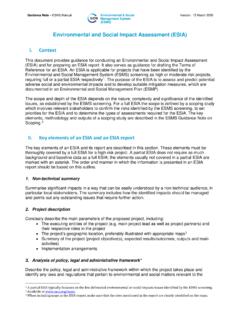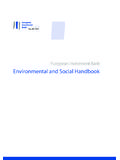Transcription of ENVIRONMENTAL AND SOCIAL MANAGEMENT PLAN (ESMP)
1 0 ENVIRONMENTAL AND SOCIAL MANAGEMENT PLAN (ESMP) DROUGHT RESILIENCE AND SUSTAINABLE LIVELIHOODS PROJECT PHASE V MINISTRY OF AGRICULTURE THE GOVERNMENT OF ERITREA APRIL 2018i Table of Contents Table of Contents .. i LIST OF ACRONYMS .. iii 1. INTRODUCTION AND THE CONTEXT OF THE ESMP .. 1 Background .. 1 ENVIRONMENTAL and SOCIAL MANAGEMENT Plan (ESMP) 2 Purpose of the ESMP and its objectives .. 3 2. ADMINISTRATION, POLICIES, LEGAL AND REGULATORY FRAMEWORKS .. 5 Introduction .. 5 ENVIRONMENTAL Governance Structures .. 6 Legal, Policies and Regulatory Frameworks.
2 7 The African Development Bank (AfDB) ENVIRONMENTAL and SOCIAL Safeguards .. 7 International Regulations and Conventions .. 8 3. THE DROUGHT RESILIENCE AND SUSTAINABLE LIVELIHOODS PROJECT PHASE V 9 Introduction .. 9 Background .. 9 Project location .. 10 Project objectives .. 11 Project components and their anticipated activities .. 11 4. PROJECT ALTERNATIVES .. 14 5. POTENTIAL ENVIRONMENTAL AND SOCIAL IMPACTS OF THE PROPOSED PROJECT .. 16 ENVIRONMENTAL , SOCIAL and climate change challenges: .. 16 Positive ENVIRONMENTAL , SOCIAL and economic impacts .. 16 Project beneficiaries.
3 17 Socio-Economic Aspects of the project .. 17 Gender and youth Aspects .. 18 Involuntary resettlement .. 18 Land Tenure and Access to Land .. 18 Climate Change and Green Growth .. 19 Negative impacts .. 20 ii 6. MITIGATION/ENHANCEMENT MEASURES .. 22 7. ENVIRONMENTAL AND SOCIAL MANAGEMENT PLAN AND MONITORING .. 25 ENVIRONMENTAL and SOCIAL MANAGEMENT Plan (ESMP).. 25 ENVIRONMENTAL and SOCIAL MANAGEMENT Plan Monitoring .. 30 Monitoring schedules .. 31 8. CONSULTATIONS AND PUBLIC PARTICIPATION .. 32 Consultative meetings held during the preparation of this ESMP .. 35 9.
4 INSTITUTIONAL ARRANGEMENTS AND CAPACITY BUILDING FOR ENVIRONMENTAL AND SOCIAL MANAGEMENT .. 36 Responsibilities for ENVIRONMENTAL and SOCIAL MANAGEMENT and monitoring .. 36 Monitoring and Evaluation .. 36 Capacity building and training needs identified .. 36 10. COMPLIMENTARY INITIATIVES .. 38 11. ESTIMATED COSTS TO IMPLEMENT THE ESMP .. 39 12. CONCLUSIONS AND RECOMMENDATIONS .. 41 Conclusions .. 41 Recommendations .. 41 iii LIST OF ACRONYMS AfDB : African Development Bank ARV : Anti-Retriviral Drugs CC : Climate Change CSS : Climate Safeguard System DRSLP : Drought Resilience and Sustainable Livelihoods Project/Programme EA : ENVIRONMENTAL assessment EIA : ENVIRONMENTAL impact assessment ESIA : ENVIRONMENTAL and SOCIAL impact assessment ESMP : ENVIRONMENTAL and SOCIAL MANAGEMENT Plan FGD : Focused Group Discussion GAP : Gender Action Plan GDP : Gross Domestic Product GHG : Greenhouse Gas GoSE : Government of the State of Eritrea HIV/AIDS.
5 Human Immunodeficiency Virus/Acquired Immune Deficiency Syndrome HIV : Human Immuno-Deficiency Virus IESIA : Integrated ENVIRONMENTAL and SOCIAL Impacts assessment ILO : International Labour Organization IPCC : Inter-Governmental Panel for Climate Change MoA : Ministry of Agriculture MoLW&E : Ministry of Land, Water and Environment iv OS : Operational Safeguards PIU : Project Implementation Unit RAP : Resettlement Action Plan RDGE : Regional Directorate for Eastern Africa UNCBD : United Nations Convention on Biological Diversity UNCCD : United Nations Commission to Combat Desertification UNFCCC : United Nations Framework Convention on Climate Change UNICEF : United Nations Children and Education Fund US : United States of America 1 1.
6 INTRODUCTION AND THE CONTEXT OF THE ESMP The proposed Drought Resilience and Sustainable Livelihoods Project Phase V in Eritrea is an integral part of the Regional Drought Resilience and Sustainable Livelihoods Programme for the Horn of Africa, regional and long term endeavor engaged by the Bank in collaboration with the Governments in the Horn of Africa. In this phase v initiative the Bank intends to address the regional and long term challenges caused by drought and climate change through resilience building and enhancement of sustainable livelihoods of the communities.
7 The objective is to enhance drought resilience and improve sustainable livelihoods of the communities in the severely drought prone regions with limited Government or donor interventions. Eritrea is one of the Greater Horn of Africa countries. It borders the Red Sea (to north-east and east), Sudan (north-west), Ethiopia (south) and Djibouti (south-east). It has a surface area of about 125,000 square km of which 117,600 km2 constitute land surface area. Of the 117,600 km2, only 17% is arable land for rain-fed agriculture while the rest are arid and semi-arid lands (ASALs) also known as rangelands or drylands that cover about 83% and receive less than 450 mm of rainfall per year.
8 These rangelands can be converted into agricultural production through alternative means that includes irrigation. Topographically, Eritrea is divided into 3 major landforms: (1) the eastern escarpment, (2) the central highlands, and (3) the western lowlands. The highlands enjoy a temperate kind of climate with moderately cool temperatures while the lowlands experience hot and dry climate. The rainfall is bi-modal, the short-rains occur in February April and the long rains come in June to September. Rainfall is highest in the central highlands which receive between 400 mm and 1000mm of rainfall annually.
9 The country is a drought prone one. Rainfall is highly erratic with uneven distribution. Averaged for the nation, the annual precipitation on the average is about 500 mm per annum. As a result agriculture is characterized by very low productivity, producing below subsistence level. In addition to this, lack of improved agricultural inputs and shortage of appropriate modern farming technologies are considered major constraints to food and nutrition security in the country. The above challenges are compounded by high unemployment rates, poverty and ENVIRONMENTAL challenges are among the main bottlenecks for inclusive growth.
10 The Agriculture sector plays a key role in the Eritrean economy and has experienced extensive improvement over recent years. It contributes about 17 percent of the country s GDP estimated at $ billion (according to 2017 estimates). The statistics available indicate that about 80% of the Eritrean rural population derive their livelihood from agriculture which is dependent on rainfall and underground water both of which are highly affected by changes in climatic conditions. Consequently, a large proportion of the population is vulnerable and food insecure with an estimated 50% of the children suffering 2 from under-nourishment.








